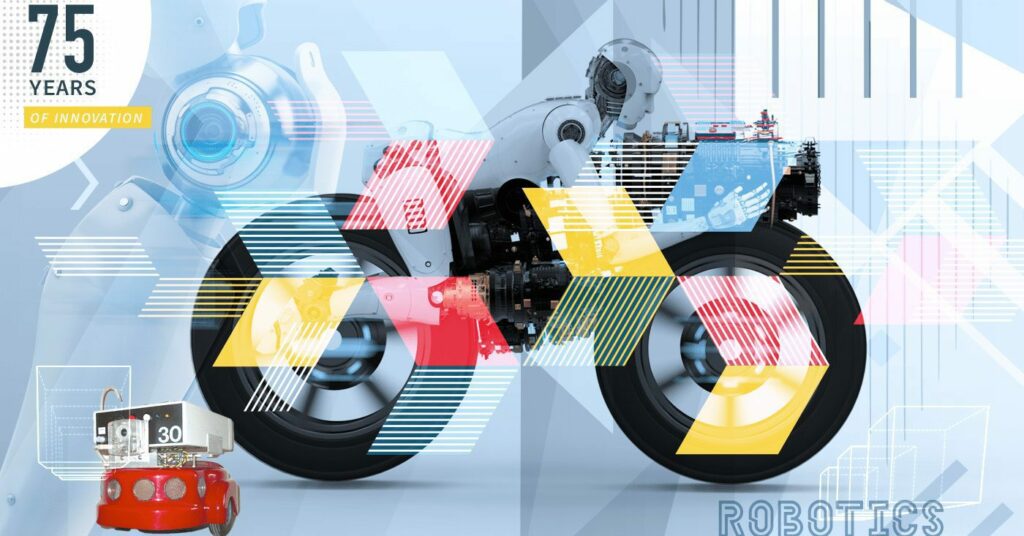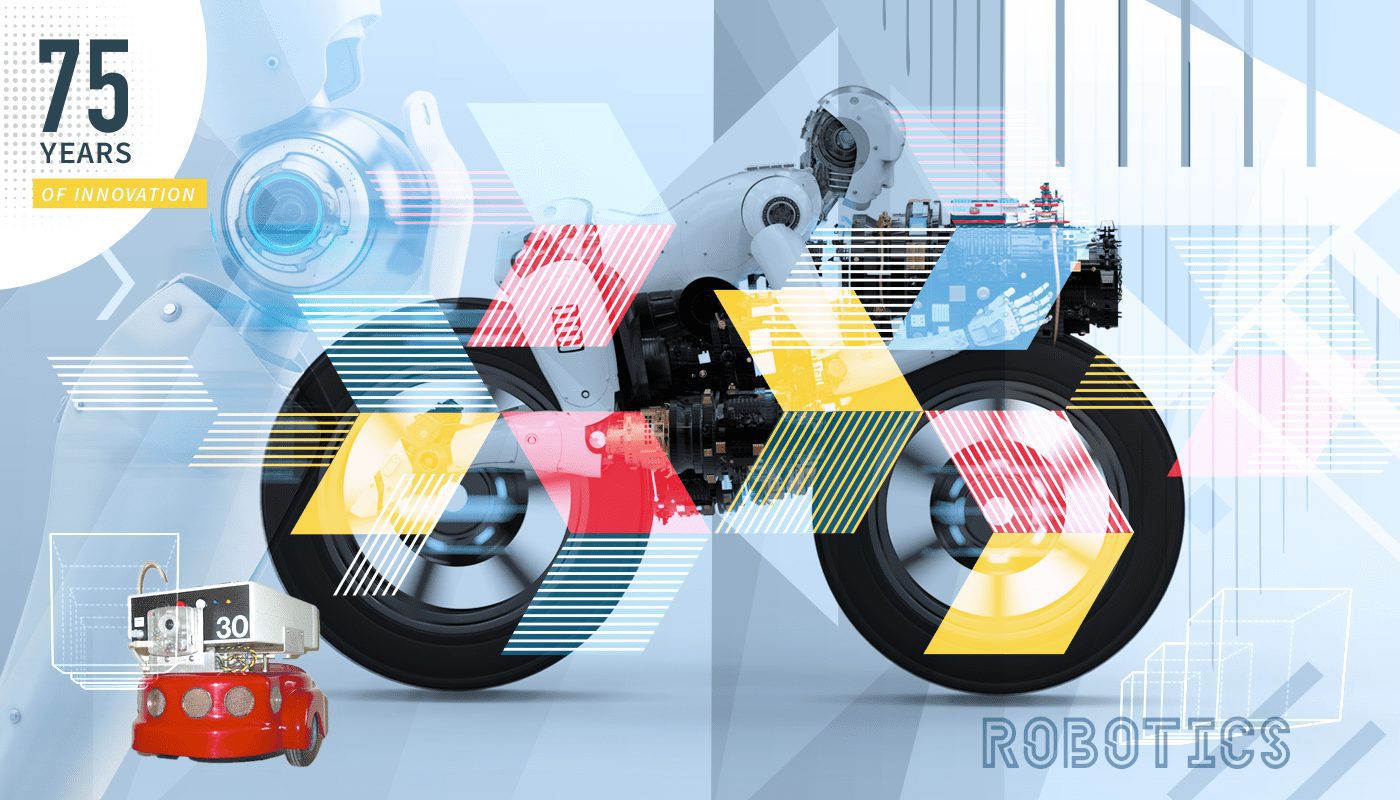Bringing machines to life for a robot-enhanced future.

The concept of the robot is enduring; for decades, our books and other media have been peppered with images of robotic futures. SRI International has worked steadily in robotics for much of its 75-years, helping to make robotics a reality. SRI’s research and practical applications have brought robotics into the here and now and provide glimpses of what is yet to come. Here are a few of the SRI innovations in robotics over the last 75 years.
How robots of the past have determined robotic futures
SRI has been involved in creating some of the world’s firsts in robotics. SRI’s robotics beginnings started with perhaps the great-grandparent of robots, Shakey. From this “shaky” beginning that integrated an ecosystem of artificial intelligence (AI) came assistant surgeons and exosuits. SRI has forged ahead in robotics, building on its past endeavors to create modern robotic systems.
Shakey the Robot
The 1960s gave birth to one of the world’s most beloved robots, Shakey. Described by John Markoff, Historian at the Computer History Museum, as the “great-grandfather of self-driving cars and military drones,” Shakey set the scene for future robotics by integrating several types of AI into one robotic unit. In 2017, 71 years after it was created, Shakey was awarded the prestigious IEEE Milestone for technical achievements.
Da Vinci/surgical robots + Taurus robotic system
SRI has long been involved in healthcare innovations. One of the areas in which SRI has provided significant contributions is robotic surgery. In 1995, Intuitive Surgical, Inc., a SRI Ventures spin-off, licensed SRI’s robotic surgery technology to commercialize the DaVinci® Surgical System. DaVinci® was the first robotic-assisted system to receive US Food and Drug Administration (FDA) approval for laparoscopic surgical use.
From the designers of DaVinci came the next robotic surgery assistant, Taurus. Lightweight and highly configurable, Taurus was designed to be used in the field and small spaces.
Centibots — coordinated robots
Often in nature, it is more effective to solve a problem using many minds. This is evident in humans as well as insects, such as ants or bees. Centibots, developed in 2002, were designed to act as a swarm, the whole being greater than the sum of the individual robot parts. Centibots communicate with each other and make decisions. Centibot swarms of robots were based on demarcation layers dedicated to different functions and could work together with little or no human interaction in difficult and dangerous situations.
Seismic (Warrior Web)
Because of developments by SRI experts, robotics can now enhance and augment the human body. In 2011, SRI began collaborating with DARPA in the Warrior Web Program to develop a robotic exosuit capable of enhancing a soldier’s muscles to alleviate the impact of carrying heavy objects. SRI spin-out company, Seismic, was created to explore how powered clothing could be used in a wide range of applications.
MOTOBOT
Possibly the coolest robot developed by SRI was MOTOBOT. MOTOBOT sat atop a Yamaha YZF-R1M motorcycle to test the bike’s safety. MOTOBOT became the world’s first autonomous motorcycle-riding humanoid robot in 2016.
Abacus Drive
SRI has helped to advance robotics a long way from Shakey’s shaky beginning. The imprecise movements of many robots were eliminated by SRI’s Abacus Drive, released in 2016. The Abacus Drive is a fixed-ratio rotary transmission gear system designed for use in robotics to facilitate smooth robotic movement.
More help from robotics in the here, now and future
The groundwork by SRI in the field of robotics is leading to amazing new developments:
Shakey paved the road to autonomous vehicles
Shakey has left a long legacy in SRI and the world of robotics. Created in the 1960s, Shakey was a revolution in robotics as one of the first autonomous robots. The AI ecosystem at the heart of Shakey was a glimpse of things to come. Many of the elements of today’s autonomous systems, such as navigation in complex environments and obstacle avoidance, were part of Shakey’s DNA. Shakey even included a nascent speech interaction interface, something that is an important element of modern robots.
Teleoperation of robots
SRI often spins out companies to take its inventions into the world of commerce. In the field of robotics, one of the most successful has been the company Intuitive Surgical. The robotic surgeons developed by SRI have created an ability to augment human performance with a precise and fine-grained robotic motion controlled from afar. Intuitive Surgical is the leader in the field of teleoperated surgical robotics. Further applications of robotic teleoperation have been in the area of “human in the loop” teleoperation of vehicles. The SRI spin-off Scotty Labs, a pioneer in this field, was recently acquired by DoorDash.
Soft, conformable exomuscles
People with muscle problems often find that the simple things we all take for granted, such as getting up off a couch or standing to cook, can be helped using an SRI development known as exomuscles. SRI has created these soft, conformable exomuscles as a kind of powered clothing. Exomuscles can augment muscles as they age, demonstrating promise for seniors and those with specific disabilities such as muscular dystrophy.
Future robot visions
SRI always has an eye on the future. The application of robotics to enhance and augment human beings is an area that SRI has its sights on, with futures including:
AI-assisted teleoperation
SRI is working on the enhancement of human performance using AI to predict a user’s needs. This will entail making the remote operation (teleoperation) of a robot even more intuitive.
Teleoperation that takes advantage of recent enhancements in AR
SRI is using further advancements in augmented and virtual reality (AR/VR) to expand the use of teleoperation; new uses of AR/VR-enabled robots include hazardous material handling, space exploration, and undersea robotics.
Far-casting of teleoperation
SRI developments also include the management of teleoperation across great distances and developing systems that can reduce or ameliorate lag time.
Swarm-based robot-human interactions
SRI is working to build upon the great strides in robotics that use AI to operate robots autonomously. However, there are many unusual cases as well as new behaviors that require human intervention to assist the AI. One example is robot swarms, like the Centibots. Swarms of robots need to interact with each other within a given environment in a highly dynamic manner. High-level human telemanagement to control a swarm is being explored as a more effective method of control than strict AI control, which requires continual retraining and refinement.
SRI’s vision of a robot-enhanced future look set to be realized. The company continues to push forward into the world of robotics, building on its long history of robotic advances from a Shakey the Robot beginning.
Resources
Shakey the Robot: https://medium.com/dish/75-years-of-innovation-shakey-the-robot-385af2311ec8
Centibots — coordinated robots https://medium.com/dish/75-years-of-innovation-centibots-e0a7ea7fef97
MotoBot (1st autonomous motorcycle) https://medium.com/dish/75-years-of-innovation-motobot-86f7ac5651b6
Da Vinci/surgical robots + Taurus robotic system https://medium.com/dish/75-years-of-innovation-the-robotic-surgeon-teleoperator-system-and-method-with-telepresence-df6dcf1e01e2
Abacus Drive https://medium.com/dish/75-years-of-innovation-abacus-drive-91f087a88c7c
Seismic (Warrior Webb) https://medium.com/dish/75-years-of-innovation-sri-superflex-suit-darpa-warrior-web-program-e39514be467a
Intuitive Surgical: https://www.intuitive.com/
Seismic Powered Clothing: https://www.myseismic.com/



